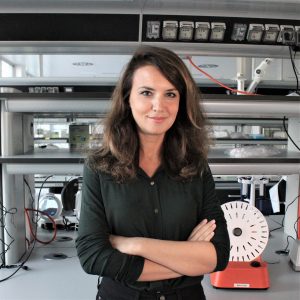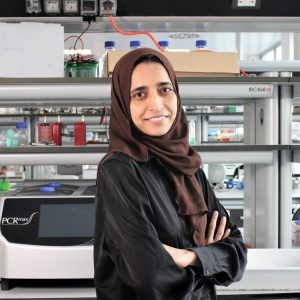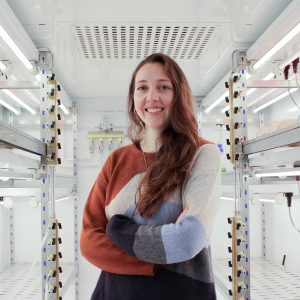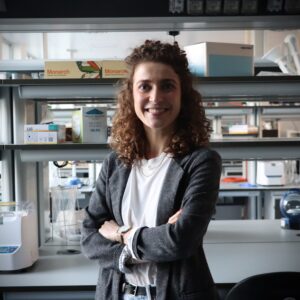
Pigino Group
Le ciglia sono organelli simili a capelli che si estendono dalla superficie di quasi tutti i tipi di cellule polarizzate del corpo umano. Sono cruciali per varie funzioni motili e sensoriali durante lo sviluppo, la morfogenesi e l’omeostasi. Le ciglia sensoriali agiscono come antenne cellulari, rilevando segnali ambientali e morfogenici. Le ciglia mobili, invece, vengono utilizzate per spingere le cellule stesse o per spostare i fluidi sugli epiteli (ad esempio nei nostri polmoni). I disturbi correlati alle ciglia (noti come ciliopatie) colpiscono molti tessuti e organi in vari modi.
La disfunzione ciliare è la causa di un numero crescente di malattie di un singolo organo e forme sindromiche complesse tra cui idrocefalo, infertilità, malattie delle vie aeree, malattie policistiche del rene, fegato o pancreas, nonché malattie della retina e difetti dell’udito e dell’olfatto.
Il Pigino Group indaga la struttura 3D dei componenti molecolari delle ciglia nel loro contesto cellulare nativo e in isolamento, cercando di capire come orchestrano le funzioni specifiche delle ciglia. Il nostro lavoro si posiziona tipicamente proprio nell’interfaccia tra biologia strutturale e biologia cellulare molecolare. Combiniamo quindi gli strumenti e le metodologie più recenti di entrambi i campi, dalla tomografia crioelettronica, alla microscopia a luce e fluorescenza correlativa (CLEM), ai sistemi dinamici ricostituiti in vitro, alla genetica, alla biochimica, ai metodi di analisi delle immagini, fino alla biologia cellulare più classica.
L’obiettivo finale del Pigino Group è comprendere le cause molecolari alla base della funzione e della disfunzione ciliare, in modo che possano essere sviluppate possibili strategie terapeutiche per le ciliopatie.
Membri del gruppo
-
 Gaia Pigino
Gaia Pigino
Associate Head of Structural Biology Research Centre -
 Gonzalo Alvarez Viar
Gonzalo Alvarez Viar
Postdoc -
 Paola Capasso
Paola Capasso
Senior Technician -
 Rubina Dad
Rubina Dad
Postdoc -
 Helen Elizabeth Foster
Helen Elizabeth Foster
Postdoc -
 Malina Karen Iwanski
Malina Karen Iwanski
Postdoc -
 Nikolai Klena
Nikolai Klena
Postdoc -
 Samuel Edward Lacey
Samuel Edward Lacey
Postdoc -
 Giovanni Maltinti
Giovanni Maltinti
PhD Student -
 Adrian Pascal Nievergelt
Adrian Pascal Nievergelt
Scientific Visitor
Pubblicazioni
-
09/2020 - Nature Structural Molecular Biology
The molecular structure of mammalian primary cilia revealed by cryo-electron tomography
Primary cilia are microtubule-based organelles that are important for signaling and sensing in eukaryotic cells. Unlike the thoroughly studied motile cilia, the three-dimensional architecture and molecular composition of primary cilia are largely unexplored. Yet, studying these aspects is necessary to understand how primary cilia function in health and disease. We developed an enabling method for […]
-
07/2020 - BiologyOpen
Filament formation by the translation factor eIF2B regulates protein synthesis in starved cells
Cells exposed to starvation have to adjust their metabolism to conserve energy and protect themselves. Protein synthesis is one of the major energy-consuming processes and as such has to be tightly controlled. Many mechanistic details about how starved cells regulate the process of protein synthesis are still unknown. Here, we report that the essential translation […]
-
05/2020 - Molecular Biology of the Cell
Reorganization of budding yeast cytoplasm upon energy depletion
Yeast cells, when exposed to stress, can enter a protective state in which cell division, growth, and metabolism are down-regulated. They remain viable in this state until nutrients become available again. How cells enter this protective survival state and what happens at a cellular and subcellular level are largely unknown. In this study, we used […]
-
08/2019 - Scientific Reports
Microridges are apical epithelial projections formed of F-actin networks that organize the glycan layer
Apical projections are integral functional units of epithelial cells. Microvilli and stereocilia are cylindrical apical projections that are formed of bundled actin. Microridges on the other hand, extend laterally, forming labyrinthine patterns on surfaces of various kinds of squamous epithelial cells. So far, the structural organization and functions of microridges have remained elusive. We have […]
-
07/2019 - Current Opinion in Structural Biology
Towards a mechanistic understanding of cellular processes by cryoEM
A series of recent hardware and software developments have transformed cryo-electron microscopy (cryoEM) from a niche tool into a method that has become indispensable in structural and functional biology. Samples that are rapidly frozen are encased in a near-native state inside a layer of amorphous ice, and then imaged in an electron microscope cooled to […]